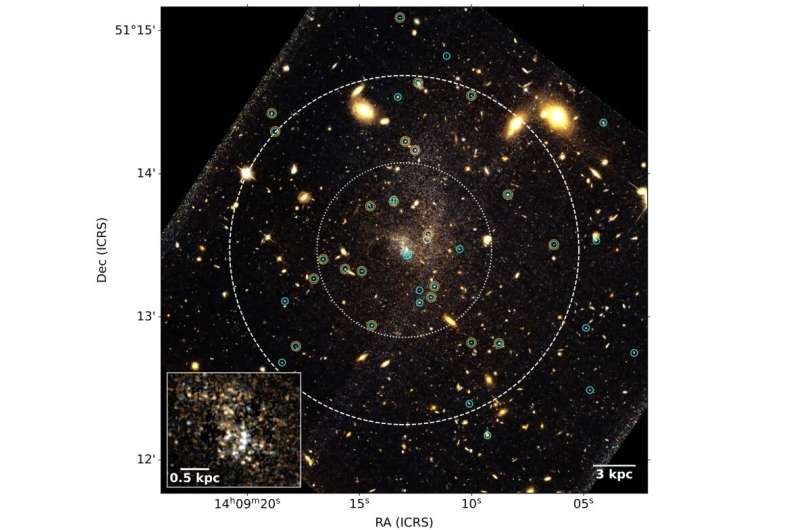Using the Hubble Space Telescope (HST) and Jansky Very Large Array (VLA), astronomers have investigated an ultra-diffuse galaxy known as UGC 9050-Dw1. Results of the study, published June 9 on the pre-print server arXiv, yield important insights into the properties of this galaxy.
Ultra-diffuse galaxies (UDGs) are extremely-low-density galaxies. The largest UDGs have sizes similar to the Milky Way, but have only about 1% as many stars as our home galaxy. The mystery of UDGs is still baffling scientists as they try to explain why these faint but large galaxies are not ripped apart by the tidal field of their host clusters.
Located some 115 million light years away, UGC 9050-Dw1 is an UDG associated with the spiral galaxy UGC 9050. It displays an evident tail-like feature, and its central region exhibits an unusual morphology, indicative of an interaction. Moreover, this UDG also shows signs of recent star formation activity.
In order to inspect these peculiarities, a team of astronomers led by Catherine Fielder of the University of Arizona in Tucson, has performed HST and VLA observations of UGC 9050-Dw1.
“We investigate the ultra-diffuse galaxy (UDG) UGC 9050-Dw1, which was selected because of its disturbed morphology as part of a larger sample of UDGs that display evidence for significant interactions,” the researchers wrote in the paper.
The observations revealed that UGC 9050-Dw1 exhibits an ultraviolet-bright elongated central core with associated gas of neutral atomic hydrogen (H I) and an extended stellar tidal plume to the north. According to the astronomers, such morphology may suggest that UGC 9050-Dw1 is currently in the process of becoming a UDG.
The results show that UGC 9050-Dw1 is an H I-bearing UDG with bright near-ultraviolet flux indicative of recent central star formation. It turned out that any interactions have not quenched the system, or must have done so very recently—in less than 100 million years. The star-formation rate of UGC 9050-Dw1 was found to be at a level of some 0.00514 solar masses per year.
The astronomers identified 52 globular clusters (GCs) in UGC 9050-Dw1, with a specific frequency of 122 and GC luminosity fraction of 21%. The GC population has a centrally peaked radial distribution, and is estimated to be at least 1.5 billion years old. The GC colors were found to be uniform and on the blue end of the GC color distribution. This indicates a possible epoch of intense star formation in which a majority of the globular clusters in UGC 9050-Dw1 formed.
All in all, the obtained data suggest that UGC 9050-Dw1 formed as a result of a rare merging event of two dwarf galaxies.
“We propose that UGC 9050-Dw1 formed via a rare dwarf merger event where induced, clumpy star formation led to its current observed properties. While these events are rare, dwarf mergers may serve as an avenue to form GC rich UDGs with relatively monochromatic GC populations,” the authors of the study concluded.



